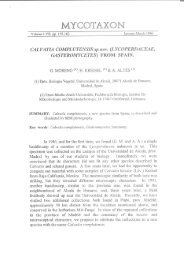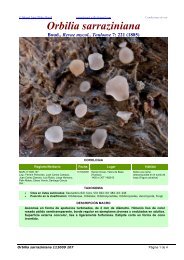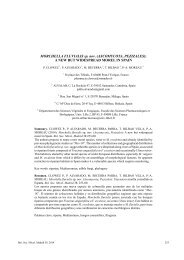Ramalina carminae (Ascomycota: Ramalinaceae), a new species from Europe
You also want an ePaper? Increase the reach of your titles
YUMPU automatically turns print PDFs into web optimized ePapers that Google loves.
Rosario Arroyo, Estela Seriñá and Elena Araujo<br />
<strong>Ramalina</strong> <strong>carminae</strong> (<strong>Ascomycota</strong>: <strong>Ramalina</strong>ceae), a <strong>new</strong> <strong>species</strong>...<br />
Tabla 1<br />
Main differences between <strong>Ramalina</strong> <strong>carminae</strong> and similar taxa<br />
Character<br />
R. <strong>carminae</strong><br />
R. capitata R. capitata R. capitata<br />
var. capitata var. protecta var. digitellata<br />
Branches width:<br />
Branching<br />
Soralia distribution<br />
Soralia morphology<br />
Soredia<br />
Apothecia<br />
Anatomy<br />
Chemistry<br />
Habitat<br />
Basal<br />
Middle<br />
Apical<br />
(0.45-) 0.78 (-1.25 mm)<br />
(0.42-) 0.85 (-1.20) mm<br />
(0.25-) 0.58 (-1.37) mm<br />
Irregularly branched,<br />
frequently twisted<br />
Scattered throughout the<br />
thallus<br />
Great morphological<br />
diversity<br />
50-80 μm<br />
Not seen<br />
Variation throughout the<br />
thallus<br />
Chondroid strands<br />
embedded in the medulla<br />
not seen<br />
Variolaric and usnic acids<br />
Sheltered acid rocks<br />
1200-2000 (2500) m<br />
(087-) 1.78 (-3.62) mm<br />
(0.75-) 1.65 (-3.75) mm<br />
(0.70-) 1.008 (-2.37) mm<br />
Regularly and palmately<br />
branched<br />
Apical<br />
Predominantly capitate or<br />
subcapitate, some<br />
labriform<br />
80-120 μm<br />
Rare, terminalsubterminal<br />
Continuous inside cortex<br />
of uneven width<br />
Chondroid strands<br />
embedded in the medulla<br />
Usnic acid (exceptionally<br />
norstictic acid)<br />
Exposed acid rocks<br />
(100-) 1000-15000<br />
(-2500) m<br />
(1.00-) 2.05 (-3.50) mm<br />
(0.75-) 2.25 (-3.50) mm<br />
(0.50-) 1.50 (-2.62) mm<br />
Regularly and pallmately<br />
branched<br />
Apical<br />
Predominantly helmetshaped<br />
40-60 μm<br />
Rare, terminalsubterminal<br />
Continuos inside cortex<br />
of uneven width<br />
Chondroid strands<br />
embedded in the medulla<br />
Usnic acid (exceptionally<br />
norstictic acid)<br />
Predominantly on<br />
sheltered acid rocks<br />
(100-) 1000-15000<br />
(-2500) m<br />
(0.87-) 1.30 (-1.75) mm<br />
(1.12-) 1.46 (-1.75) mm<br />
(0.50-) 0.85 (-1.12) mm<br />
Regularly and palmately<br />
branched<br />
Apical<br />
Under thin finger-shaped<br />
branches<br />
50-60 μm<br />
Not seen<br />
Discontinuous inside<br />
cortex of uneven width<br />
Chondroid strands<br />
embedded in the medulla<br />
not seen<br />
Usnic acid (exceptionally<br />
norstictic acid)<br />
Predominantly on sheltered<br />
acid rocks (100-) 1000-<br />
15000 (-2500) m<br />
tion between the morphological, chemical and anatomical<br />
differentiation, we recognize R. <strong>carminae</strong> as a <strong>new</strong> <strong>species</strong>.<br />
From the different sites where R. <strong>carminae</strong> was collected,<br />
only in the populations of Montejo de Tiermes (Soria)<br />
there were specimens parasited with Lichenoconium<br />
usneae (Anzi) D. Hawksw., Phaeosporobolus usneae R.<br />
Sant. and Tremella ramalinae Diederich (S. Pérez Ortega,<br />
per. comm.).<br />
Additional specimens examined. ITALY: SARDINIA: 1250 m, esquistos,<br />
P.L. Nimis 1989, nº 307 B&L (1992) (TSB); 1300 m, esquistos,<br />
P.L. Nimis 1989, nº 304 B&L (1992) (TSB). PORTUGAL: BEIRA<br />
ALTA: 650 m, granitos, (PO 5246L). Trás-Os-Montes: 29T6861 4645,<br />
Montesinho, 1280 m, A. Terrón 2006, granitos, bird perches (LEB<br />
6943). SPAIN: ALMERÍA: Bacares: 30S542 4119, Sierra de los Filabres,<br />
Merendera, 1984 m, J.M. Egea 1978, (Arroyo 1561, 1563,1564)<br />
MUB 1019 (BCN); Gergal: 30S534 4118, Sierra de los Filabres, Piedra<br />
del Sombrero, 1900 m, J.M. Egea 1982, (Arroyo 2685, 2687)<br />
(BCN). ÁVILA: 30T319 4471, Sierra de Gredos: Navarredonda de Gredos,<br />
1600 m, R. Arroyo & J.J. Pérez 1988, (Arroyo 3237-3240, 3242,<br />
3243, 3245-3251, 3253-3262, 3264-3266) (MACB 102148, 102150-<br />
102154); 30T 3055 44593, Risco Negro, (Circo de Gredos), 2300 m,<br />
L.G. Sancho 1982, (Arroyo 809-812, 814, 816) (MACB 102147,<br />
102149). GRANADA: Guadix: 30S531 4118, Sierra de Baza, Piedra del<br />
Deseo, 1900 m, J.M. Egea 1979, (Arroyo 1555-1559) MUB 1018<br />
(BCN); Sierra Nevada: 30S468 4107, Peñones de San Francisco, 2500<br />
m, J.M. Egea 1980, (Arroyo 1566, 1567, 1569, 1570) MUB 1020<br />
(BCN). GUADALAJARA: 30T59938 449553, Parque Natural Alto Tajo:<br />
Chequilla, 1360 m, E. Araujo & T. Camarero 2009, [Arroyo 4336 (1-<br />
3)] (MACB 102138). MADRID: 30T455 4545, Montejo de La Sierra:<br />
Hayedo de Montejo, 1300 m, R. Arroyo 1986, (Arroyo 243, 245, 247-<br />
251) (MACB 102156, 102157). 30T407 4511, Sierra de Guadarrama:<br />
La Peñota, 1600 m, L.G. Sancho 1978, (Arroyo 765-772) (MACB<br />
102158); 30T402 4497, El Escorial, Monte Abantos, 1754 m, R. Arroyo<br />
& J. J. Pérez 1988, (Arroyo 2491-2530, 2532-2544) (MACB 102140-<br />
102145); 30T431 4519, Puerto de la Morcuera, 1450 m, A. Pintado<br />
2006, s/n (MAF); A. Pintado & R. Arroyo 2006 [Arroyo 4327, 4328,<br />
4330, 4331 (1,2), 4332(1-5)] (MACB 102132-102136). 30T42 451,<br />
Manzanares El Real, La Pedriza de Manzanares (al pié de Cabezas de<br />
12 Botanica Complutensis 35: 5-14. 2011






